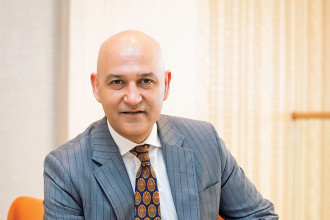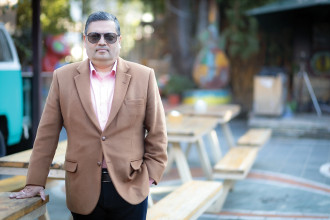-1709875059.jpg)
Sir Graham Wrigley
Founder, Samriddha Pahad
Ever since visiting Nepal and India in 1981, Sir Graham Wrigley had wanted to work in international development. So, 13 years ago, he quit his business career and decided to ‘retrain’ for a new career by completing an MSc in Development Economics at SOAS. Since then, he has worked in a variety of roles with SMEs and microfinance organisations in sub-Saharan Africa, Nepal and the poor states of North India, with a personal goal of helping these companies become sustainable and help their countries’ economic development.
Wrigley’s first career was in business. He was a founder partner of Permira and a member of the firm’s management board as it grew into one of the world’s leading private equity firms, with over $20 billion under management. Prior to that he worked for Bain & Co. He was also Chairman of CDC, the UK Government’s private sector development arm.
Wrigley was knighted in the 2020 Queen’s Birthday honours list for services to international development spanning 32 years. He works with several charities, including Sir Edmund Hillary’s Himalayan Trust UK, where he serves as Chairman, and has volunteered for them for over 35 years. He is also the Founder and donor of Samriddha Pahad since 2009.
Excerpts of a conversation with the exceptionally committed and visionary Sir Graham Wrigley on why he founded Samriddha Pahad, the challenges of working in Nepal, and how he measures the impact of his work.
When did you first come to Nepal and how did you decide to work in philanthropy here?
The first time I came to Nepal was 1981. I was in between school and going to Cambridge and I travelled around India and Nepal. I had £1 a day for nine months. I had always read about the mountains and I used to climb a little bit in England and I wanted to come see Mount Everest. I went up around Mount Everest and around Pumori.
One day, I was sitting on a wall outside the Khumjung School and I got talking to this quite big, old guy, probably in his 60s but he felt old to me. I was only 18 then. I got talking to him for about 45 minutes and he asked, what have I been doing? And I basically, like what young people do, boasted about how I had climbed peaks that were 6,200 metres tall. He said it must have been fantastic and must have been hard. And I again boasted that it was hard but I had done it and went on to speak about climbing mountains. It was only later when the man had left that a Sherpa who was with me asked if I knew who I was talking to. I had been boasting to Edmund Hillary, the man to conquer Mt Everest for the first time, for 45 minutes. I also realised I was standing in front of a school that was built by Hillary. I was so embarrassed I just couldn’t walk up to him and apologise. After Cambridge, I started raising money for the Himalayan Trust, which is Hillary’s charity set-up. I organised these balls in London called the Yeti Balls, and we gave him money to say this is because I was so impressed by what he had done for the community in Khumjung.
I had always felt a bit guilty when I went in my gap year before university and I took another year travelling. I didn’t do any volunteering. I just did training and travelling. I always told myself at the time, I’d be more useful as a volunteer when I am older, so I’ll do it after my career.
So really, it were those two things. Meeting Edmund Hillary, being inspired by him, and thinking that actually maybe I could do things a bit differently after I have made some money, had my career, that I could do something in development.
When did you decide to start Samriddha Pahad? What are its core principles?
That was something much later. I went to university in the 80’s and then I started working for Bain & Co. Later, I co-founded a private equity firm called Permira, which is quite a big business. We started from not much but by the time I left the company it was handling $20 billion in assets. I was one of the six persons running Permira. During my time at Permira, I decided I really wanted to do this second career. I thought I’d been very fortunate and I could have the time if I retired early. So, in 2006, I stepped down and then I went to the School of Oriental and African Studies in London and studied Development Economics. My father at that time was a research scientist and my mother was a teacher, and I thought why not get involved in international development, may be in the health or education sector.
However, it soon dawned on me that I wouldn’t be adding any value because there were already teachers and doctors who had studied those subjects and I was not getting any younger. I was 43 years old at that time. So, I started thinking of what different thing did I have in me. I realised the different thing that I had was the 20 years of learning about business and investments. Moreover, developing countries don’t need just development and public healthcare systems and education. They need business because it’s business that creates employment, creates taxes and it gives people opportunities. However, I knew from my time in the investment world that without capital it was very hard to do things. I knew that a lot of poorer countries did not have enough capital. I, thus, thought I should spend my life working on bringing international capital to help businesses in low-income countries.
I then started working on SME investing and also on microfinance. If you remember, back in late 2000, microfinance sector faced a crisis and I did my dissertation that asked whether microfinance would be the new subprime. I wanted to learn about microfinance and I read about Grameen. I wanted to work in India, so I started visiting the country regularly and meeting lots of microfinance firms like SKS Microfinance and Spandana Sphoorty Financial. I thought it was a good thing but then I realised that they were moving too fast and going to the same places. They were competing with each other in Mumbai and particularly in Bangalore and Andhra Pradesh. It was unregulated, irresponsible lending.
I then found Cashpor Micro Credit, which was a not-for-profit Section 25 company. It made profits but could not distribute it to the shareholders. It could only give away charitable funds and services. It was founded by David Gibbons in the 90’s. It was growing but it got in a bit of trouble at that time. The company then decided to go to places where there was no other microfinance company but there was a need for money. It started working from Varanasi in the rural areas of Uttar Pradesh and Bihar. It was amazing and I started working with them. I was on the board and I put in some money and recruited a team of people to help them. This experience inspired me to work in the microfinance sector in Nepal.
I had been coming to Nepal for many years as I was working with the Himalayan Trust where we focused on just education and health. And I thought actually in these remote areas you need access to finance. In 2009-10, I commissioned some people I had been working with at Cashpor and an Indian consultancy company to work with RMDC, which was being led by Shankar Man Shrestha. I remember visiting his office and there was a map on the wall with small dots marking the places where there was access to microfinance but everything was in the Terai region. This was obvious because microfinance then and till now is largely group-based lending and it works if you have got a loan officer who can cover 300 to 400 loans. Up in the mountains you can’t get on your bike and go from village to village.
There was no access to microfinance in the mountain region of Nepal and we started working on that. I then got to know Ashoke Rana, CEO of Himalayan Bank, and he was very helpful. We looked at the mountain communities in Pakistan, Colombia, Peru, just anywhere where there was access to finance issues in mountain areas. We then thought of coming up with something called mountain finance.
What’s your guiding philosophy?
The first one was to do things where I knew we were being additional. An additional is a development word for doing things other people wouldn’t do. We wanted to help encourage the private sector. Secondly, we wanted to be friends with the private sector and banks. Thirdly, we went to certain areas and did a two-by-two matrix to see if there was potential for economic development. We then asked ourselves are there banks there at the moment? If the answer was yes, we wouldn’t go there. Also, if there was no potential for economic development we wouldn’t go there. We would go to those areas where there were no banks but there was a potential for economic development.
The next principle we followed was we should work off the Nepalis, although we learned from different models of ways of doing it. And the key insight we had was that in mountain areas, Grameen based lending didn’t work. There were lots of cooperatives in Nepal and we felt we should focus on working with institutions that already existed. We developed a screening model with RMDC and visited different areas and screened almost a thousand cooperatives. Some were not being run properly, some were political and some had corruption issues. And there were some genuine ones who needed assistance and with whom we could work. We then developed technical training packages and started working with them to create what they needed. We would work with those cooperatives for sometimes six months, sometimes two years, and then we would take them to banks like Himalayan Bank and Nabil Bank. These banks couldn’t go to these areas as the loans were too small. By us going there and packaging them together we could end up with a $100,000 loan and then that would be lent out.
My other goal was eventually to hand this over, because we set up Samriddha Pahad as an INGO funded by a charity that I set up in the United Kingdom. We then transferred it over to a Nepali company, a social business and it is chaired by Prithvi Bahadur Pandé, Chairman of Nepal Investment Mega Bank. We have some great members on the board and a fantastic CEO in Sanjeev Neupane. There are lots of people who claim credit for starting this concept of mountain finance but I honestly think we were one of the pioneers in making this happen.
At present, with mobile telephony a lot of people can get access to finance and banks can set up branchless structure. But we still have around 25,000 clients working in, I think, about 115 cooperatives and they have all paid their money back. A lot of people, a lot of bankers, didn’t trust the mountain people. I know from my life, the mountain people are some of the most trustworthy.
-1709875060.jpg)
What are the challenges of working in Nepal and how do you overcome them?
I have done other things too in Nepal. I was the chairman of British International Investment when we set up office. I am no longer chairman as it was for a fixed term. We now have over $100 million invested. I am not criticising Nepali culture but getting things done here takes a pretty long time. I feel some people are somewhat untrusting of international partners. I understand the reasons for it but it all adds time. Getting permits to set up business is time consuming and banking approvals also take a long time. For hydropower, it at times takes forever. It is a very difficult thing. It’s a tragedy for Nepal because I really do believe that Nepal can be the Saudi Arabia of hydropower. This really does need to change.
I did mention time but the enabling environment of most things is the biggest problem which is the infrastructure. So, what we are doing in Kanchenjunga is working on a small scale development project. How do we get clean water and heating to the area before the tourists come? Tourism is being promoted in the region but water and heating are prerequisites. And if we don’t provide heating facilities, then the locals could cut down the trees. So that’s a challenge. The next thing is related to the manufacturing of carpets, which is an export commodity, and there is not enough power. There are always outages and that is terrible. Even the schools and hospitals don’t have access to electricity. I remember being here between the two earthquakes and there was actually a blockade, when there was no fuel and no power.
How do you measure the impact of your work in Nepal?
Within Samriddha Pahad, we have looked at how many people were given access to finance. We did a baseline of what happened to that income over time and it grew quite significantly to 75%. When you give people access to money in areas where they don’t have any, it’s profound. If you take education and health, the other areas where I work on through the Himalayan Trust, then we technically look at the results of the schools and also the ratings by the teachers and the parents and the attendance rates. On the health side, we look at mortality rates. We have a baseline and we compare it with the national average.
For the Kanchenjunga project that Samriddha Pahad is involved in, we will look at how many tourists are coming and how we can manage that without harming the environment. Then we will look at what is going to happen to incomes in the whole area. And we think that in 10 years’ time we could bring an extra $30 million to the country through British International Investment. The current team is doing it, not me. But for every investment they have a set of metrics specifically related to that thing.
Any defining moment in your work here or any story that you would like to narrate during the course of your work here?
This year is the 70th anniversary of the first ever ascent of Mount Everest. We were at Khumjung School and this is with the Himalayan Trust New Zealand, Himalayan Trust UK and Himalayan Trust Nepal. A lot of great Sherpa personalities have studied there. We have also opened the Sir Edmund Hillary Memorial Museum and Elder Care Centre there. Things are happening there and it is a satisfying feeling. And now we are working in the Kanchenjunga region. When you see the people that you have helped reach great heights there is no feeling better than that.
You mentioned the Kanchenjunga project quite a number of times. What exactly does it involve?
If you look at the tourism scene during the pre-Covid time in Nepal, then around 70,000 people visit the Everest region annually and approximately 150,000 go to the Annapurna region. However, the Kanchenjunga area received only 600 to 800 tourists annually. Literally, nobody goes there. But mind you it is a beautiful place and that is an opportunity. What we are trying to do is seize on the opportunity whilst mitigating threats. There are opportunities to develop the area into a tourism hub. We want to develop lodges there, high-end lodges which are of high quality and not the $20-a -day type of lodges. I believe Western tourists should be paying top dollars when they go to a national park in Nepal too. For instance, if you went to the Yosemite National Park in California you would be paying thousands of dollars for five days. So, here too the charges should be accordingly which will in turn help in bearing the cost for preserving the environment. So, we are building the infrastructure. We are trying to make clean water available so that people do not have to bring in plastic bottles. We want to bring in renewable energy so people don’t have to avail heating by cutting down trees. That is our plan.
How do you raise the financial resources for the work you do in Nepal?
I have been funding it but Himalayan Bank and Nepal Investment Mega Bank will be putting in money. However, we are looking for other partners and we will always look for the local communities to contribute too. Because one of the principles of Samriddha Pahad is to work with the communities. We are working very closely with Kanchenjunga Conservation Area Project who are also contributing. That is a joint venture.



-1744694423.jpg)

-1738128188.jpg)
